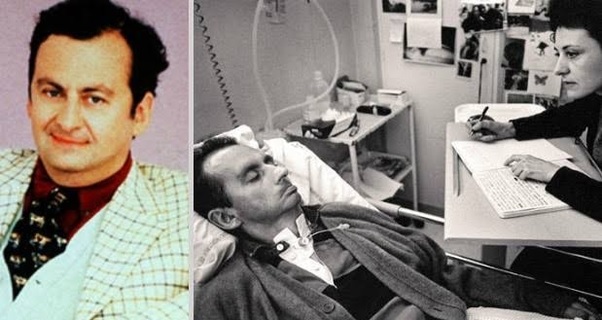Locked-In Syndrome: The True Story of Jean-Dominique Bauby

Jean-Dominique Bauby, a name that resonates with remarkable resilience, left an indelible mark on the world with his inspiring memoir, *The Diving Bell and the Butterfly*. His story is one of courage in the face of Locked-In Syndrome, a rare condition that rendered him almost completely paralyzed yet left his mind untouched.
This article explores Bauby’s life, his experience with Locked-In Syndrome, and his celebrated work, *The Diving Bell and the Butterfly*, which chronicles his journey of survival, reflection, and creative triumph over physical limitations.
Early Life and Career of Jean-Dominique Bauby
Jean-Dominique Bauby was born on April 23, 1952, in Paris, France. Known as “Jean-Do” to his friends, Bauby grew up in a cosmopolitan French society that would shape his sophisticated outlook. He started his career as a journalist and editor, quickly establishing himself as a leading figure in French media. His career reached a pinnacle in the early 1990s when he became the editor-in-chief of the prestigious French fashion magazine *Elle*, a publication that was influential in setting trends across Europe.
As editor of *Elle*, Bauby’s creative flair and keen insight earned him a reputation as a prominent intellectual and cultural figure. Known for his wit, charm, and talent, he was the kind of man who lived life fully, enjoying the pleasures and privileges of a successful career, a loving family, and a vibrant social life. However, Bauby’s life took a dramatic turn in December 1995 when he suffered a massive stroke, leaving him with Locked-In Syndrome at just 43 years old.
Locked-In Syndrome: Understanding the Rare Condition
Locked-In Syndrome (LIS) is a rare neurological condition in which a person experiences complete paralysis of nearly all voluntary muscles except for those controlling eye movements. Often caused by brainstem strokes, LIS is devastating in its effects: the person is fully conscious and retains cognitive function but cannot move or communicate verbally. Essentially, they are “locked in” their own body, unable to express themselves in any conventional way.
In Bauby’s case, the stroke damaged his brainstem, severing the connection between his brain and body while leaving his mind intact. He could only blink his left eye, which became his sole means of communicating with the outside world. Despite these staggering limitations, Bauby exhibited an extraordinary will to live, adapt, and express himself, even as he remained aware of his tragic reality. His experience with Locked-In Syndrome was unique not only for its severity but also for how he chose to respond to it.
Adapting to Locked-In Syndrome: Bauby’s Path to Communication
In the days following his stroke, Bauby was transferred to the Naval Hospital of Berck-sur-Mer, a coastal town in northern France. Initially, he was confined to his hospital bed, overwhelmed by his condition. It was in these dire circumstances that a team of compassionate caregivers, family members, and friends helped him find a way to communicate using the blinking of his left eye.
Bauby’s physical therapist, Henriette Durand, created a special system for him to communicate through a process known as “partner-assisted scanning.” In this method, a caregiver would recite letters of the French alphabet arranged in order of frequency of use, and Bauby would blink to select a letter. Through this painstaking process, letter by letter, word by word, he began to communicate again. The slow pace of this method was both frustrating and liberating, as it allowed Bauby to reconnect with his loved ones and ultimately create his memoir.
The Diving Bell and the Butterfly: A Testament to the Human Spirit
With his newfound ability to communicate, Bauby made the extraordinary decision to write a book about his experiences with Locked-In Syndrome. *The Diving Bell and the Butterfly*, dictated entirely through blinking, was completed over several months. Published in 1997, it became an international sensation, earning praise for its poetic language, emotional depth, and unique insight into the human spirit.
In *The Diving Bell and the Butterfly*, Bauby uses rich metaphorical language to convey his experiences. He describes his body as a “diving bell” that imprisons his mind, while his imagination and memories serve as his “butterfly,” allowing him fleeting moments of escape. This powerful contrast reflects the tension between his physical confinement and his mental freedom. The memoir is not only a record of his daily struggles but also a meditation on life, identity, and the essential connection between body and mind.
Bauby’s writing paints a vivid picture of his internal world: the frustrations of daily life in a paralyzed state, the memories of his vibrant past, and the resilience he cultivated to survive in his new reality. The memoir takes readers through his reflections on family, friends, food, love, and loss, bringing to light both the trivial and profound aspects of existence. Bauby’s unflinching honesty and sharp wit shine throughout the text, as he shares both humorous and heartbreaking insights.
The Impact and Legacy of *The Diving Bell and the Butterfly*
*The Diving Bell and the Butterfly* was published just days before Bauby’s death on March 9, 1997. Despite his passing, Bauby’s legacy continued to grow, and his memoir remains a celebrated work of literature. The book has been translated into over 30 languages and has inspired millions around the world, from those with physical disabilities to individuals facing any kind of adversity.
In 2007, *The Diving Bell and the Butterfly* was adapted into a critically acclaimed film directed by Julian Schnabel. The film received high praise for its sensitive portrayal of Bauby’s life, winning awards at the Cannes Film Festival and earning multiple Academy Award nominations. The visual representation of Bauby’s world in the film further cemented his story in popular culture, bringing awareness to Locked-In Syndrome and humanizing the experience of those who endure it.
The book and film underscore themes of resilience, creativity, and humanity that transcend Bauby’s condition. His ability to create a literary masterpiece through such a laborious process has resonated deeply, demonstrating that personal limitations do not have to prevent the expression of one’s inner life.
Locked-In Syndrome Awareness: How Bauby’s Story Changed Perspectives
Bauby’s story has also raised awareness about Locked-In Syndrome, helping others understand a condition that is often misunderstood or misrepresented. Before *The Diving Bell and the Butterfly*, few people knew about Locked-In Syndrome or its devastating impact on individuals and their families. Bauby’s experience highlighted the need for greater research, support, and empathy for those with severe disabilities.
Organizations dedicated to supporting individuals with Locked-In Syndrome have since grown, offering resources and building communities for individuals affected by similar conditions. Bauby’s memoir has also led to advancements in assistive technologies, such as eye-tracking devices and brain-computer interfaces, which allow people with limited physical mobility to communicate more easily. Bauby’s experience has therefore contributed to a broader movement of technological innovation and accessibility for people with severe disabilities.
Frequently Asked Questions (FAQ) about Jean-Dominique Bauby, Locked-In Syndrome, and *The Diving Bell and the Butterfly
1. Who was Jean-Dominique Bauby?
Jean-Dominique Bauby was a French journalist, author, and former editor-in-chief of *Elle* magazine. He is best known for his memoir, *The Diving Bell and the Butterfly*, which he wrote after being diagnosed with Locked-In Syndrome following a severe stroke in 1995.
2. What is The Diving Bell and the Butterfly about?
*The Diving Bell and the Butterfly* is Bauby’s memoir, where he describes his life before and after developing Locked-In Syndrome. The book reflects on his experience of being fully aware but paralyzed, his memories, his family, and his unique observations about life. He used a special blinking system to dictate each word of the memoir.
3. What is Locked-In Syndrome?
Locked-In Syndrome (LIS) is a rare neurological condition where a person is fully conscious but unable to move nearly all voluntary muscles, often retaining only the ability to blink or move their eyes. People with LIS have intact cognitive abilities but cannot communicate in typical ways due to their severe paralysis.
4. How did Jean-Dominique Bauby communicate?
Bauby communicated by blinking his left eye. A therapist and caregivers developed a method using a frequency-based alphabet system where Bauby would blink to select letters, forming words and sentences to communicate. This is the same method he used to “write” his memoir.
5. How long did it take to write *The Diving Bell and the Butterfly*?
Writing the memoir was a lengthy process that took several months. Each word had to be painstakingly spelled out letter by letter using the blinking method. Despite these challenges, Bauby managed to complete the entire book this way, demonstrating extraordinary determination.
6. What do the “diving bell” and “butterfly” in the book’s title symbolize?
In Bauby’s memoir, the “diving bell” represents his paralyzed body, which traps him in a state of immobility, while the “butterfly” symbolizes his mind and imagination, which remain free to explore memories, thoughts, and creativity despite his physical confinement.
7. When was *The Diving Bell and the Butterfly* published?*
The book was published in 1997, just days before Jean-Dominique Bauby passed away. It became an instant bestseller and received critical acclaim worldwide.
8. Has *The Diving Bell and the Butterfly* been adapted into a film?
Yes, in 2007, a film adaptation of the book was directed by Julian Schnabel. The film received critical acclaim and won several awards, including at the Cannes Film Festival. It was also nominated for multiple Academy Awards.
9. How did *The Diving Bell and the Butterfly* impact awareness of Locked-In Syndrome?
Bauby’s memoir brought international attention to Locked-In Syndrome, helping readers understand the experiences of those with this condition. It raised awareness about the need for support, compassion, and assistive technologies for people with severe disabilities.
10. What are some themes in *The Diving Bell and the Butterfly*?
Major themes include resilience, the power of imagination, human connection, the limitations of the body versus the freedom of the mind, and the importance of appreciating life’s small moments. Bauby’s work inspires readers to reflect on their own lives and challenges.
11. What lessons can be learned from Jean-Dominique Bauby’s story?
Bauby’s story teaches the importance of resilience, adapting to adversity, appreciating life, and finding strength in the face of hardship. His ability to create a literary masterpiece under extreme conditions serves as an inspiring example of human determination.
12. Where can I read *The Diving Bell and the Butterfly*?
*The Diving Bell and the Butterfly* is widely available at bookstores, online retailers, and in libraries. It has been translated into multiple languages and remains popular with readers around the world.
